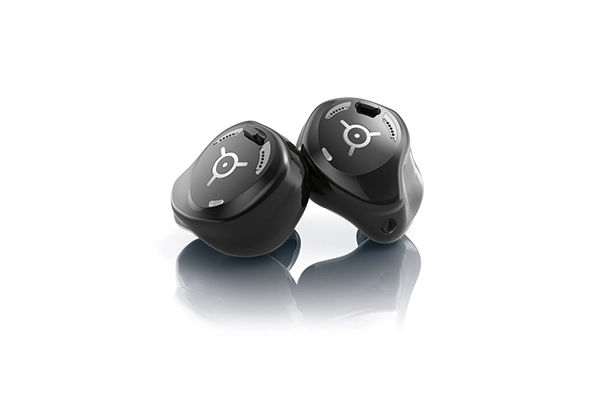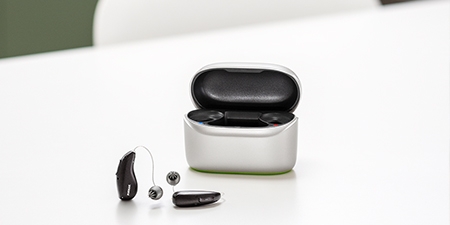In-the-Ear Hearing Devices: A Comprehensive Guide

In-the-Ear Hearing Devices: A Comprehensive Guide
15 min
Published September 8, 2025
Hearing loss can be a challenging condition to navigate, affecting millions of individuals worldwide. Fortunately, advancements in hearing aid technology have led to the development of various devices, including in-the-ear (ITE) hearing aids. In this article, we will explore what ITE hearing devices are, how they work, the different types available, their distinctions from behind-the-ear (BTE) devices, considerations like an uncomfortable sensation known as hearing aid occlusion, scenarios in which ITEs are preferred over BTEs, and their compatibility with modern technology.
What is an ITE Hearing Device?
An ITE hearing device is a type of hearing aid that is custom-made to fit directly within the wearer's ear canal. These devices are designed to amplify sounds and improve the wearer's ability to hear and communicate effectively. ITE hearing aids are discreet, as they are positioned inside the ear, making them less visible compared to BTE devices.
How Does an ITE Hearing Device Work?
ITE hearing devices function by capturing sound from the surrounding environment using a microphone. The sound is then processed by an amplifier and tailored to the wearer's specific hearing needs. Finally, the amplified sound is delivered through a speaker directly into the ear canal, allowing the wearer to perceive sounds more clearly.
What Are the Different Types of ITE Hearing Devices?
There are several types of ITE devices, each catering to different degrees of hearing loss and individual preferences²:
What is the latest ITE Device on the market?
Phonak has just launched the Virto™ R Infinio. The device is the first custom-fit rechargeable hearing aid. It houses Phonak’s latest ERA™ chip with SmartSpeech™ Technology, features that were only available in BTE model hearing aids. The Virto R Infinio is a perfect example how advances in hearing aid technology allow for more and more features to fit in the smaller, discreet styles.

How Does an ITE Device Differ from a BTE Device?
The primary distinction between ITE and Behind-the-Ear (BTE) hearing devices lies in their placement and design. While ITE devices are custom-made to fit inside the ear canal, BTE devices rest behind the ear, coupled to a receiver-in-the-canal or an earmold. BTE devices are typically larger and offer more power, making them suitable for severe to profound hearing loss. In contrast, ITE devices are often preferred for their discreet appearance and comfort.¹,³
What is Hearing Aid Occlusion?
One common concern with ITE hearing devices is hearing aid occlusion, a sensation of ear fullness or echo caused by the blocked ear canal. This phenomenon can affect the wearer's perception of their own voice and can cause discomfort. However, Phonak’s Virto R Infinio does have great acoustically optimized venting which allows for better airflow and natural sound perception. Make sure the model of hearing aid you are interested in features those vents and then keep them clean and clear of ear wax with frequent cleanings.
When is an ITE Device Preferred over a BTE Device?
The choice between an ITE and a BTE device depends on individual hearing needs and preferences. ITE devices are preferred in the following scenarios:⁴
- Cosmetic Concerns: Individuals who prioritize a discreet appearance often choose ITE devices due to their custom-fit design that sits inside the ear canal.
- Mild to Severe Hearing Loss: ITE devices are suitable for a wide range of hearing loss, from mild to severe, offering flexibility in addressing different levels of hearing impairment.
- Comfort: ITE devices are custom-made to fit the wearer's ear, providing comfort and a secure fit.
- Reduced Feedback: The position of ITE devices within the ear canal minimizes audio feedback and noise interference.
Can Anyone Wear an ITE?
There may be cases where an ITE is preferred for one or more of the above reasons, but it is not feasible to make due to the size of the ear canal.
All the working components (microphone, receiver, amplifier, etc.) of the device need to be housed within the ITE casing in the ear canal. Therefore, an ITE may not be possible to make for someone with small or narrow ear canals.
Are ITEs Rechargeable and Bluetooth Compatible?
Many modern ITE hearing aids are equipped with rechargeable batteries, eliminating the need for disposable batteries and simplifying maintenance. Additionally, these devices often feature Bluetooth connectivity, allowing wearers to connect to smartphones and other compatible devices. This enables hands-free phone calls, audio streaming, and remote control through dedicated apps, enhancing the overall user experience.
Summary
In-the-ear (ITE) hearing devices have revolutionized the way we address hearing loss. Custom-made to fit discreetly within the ear canal, these devices offer comfort, flexibility, and advanced technology to improve the lives of individuals with hearing impairments. With options catering to various degrees of hearing loss, ITE hearing devices like the Virto™ R Infinio are a compelling choice for those seeking both functionality and aesthetics in their hearing aids.
References
¹ Cleveland Clinic. (2022). Types of Hearing Aids. https://my.clevelandclinic.org/health/articles/5122-hearing-aid-styles
² Mayo Clinic. (2021). In-the-ear (ITE) hearing aids. https://www.mayoclinic.org/diseases-conditions/hearing-loss/in-depth/hearing-aids/art-20044116
³ Hearing Link (2023). What is a hearing aid? https://www.hearinglink.org/your-hearing/what-is-a-hearing-aid/
⁴ Hearing Aid (2023). In-the-ear (ITE) vs Over-the-Ear (OTE) Hearing Aids https://www.hearingaid.org.uk/hearing-aid-advice/the-pros-and-cons-of-in-the-ear-ite-and-over-the-ear-ote-hearing-aids




